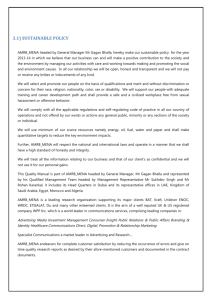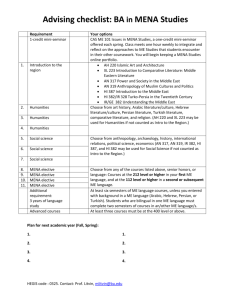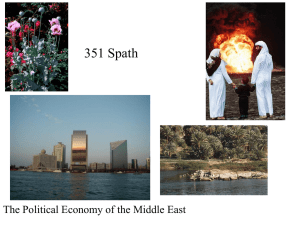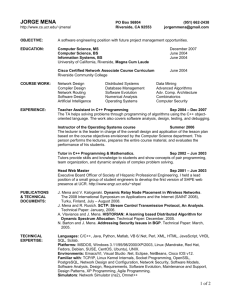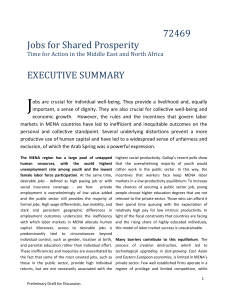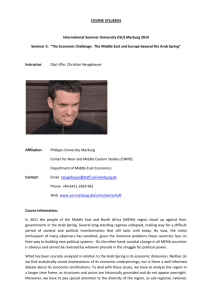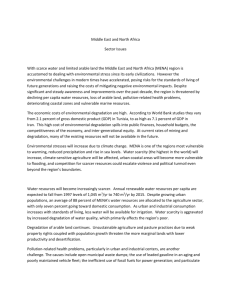The Paradox of Female Economic Participation in the Middle East
advertisement
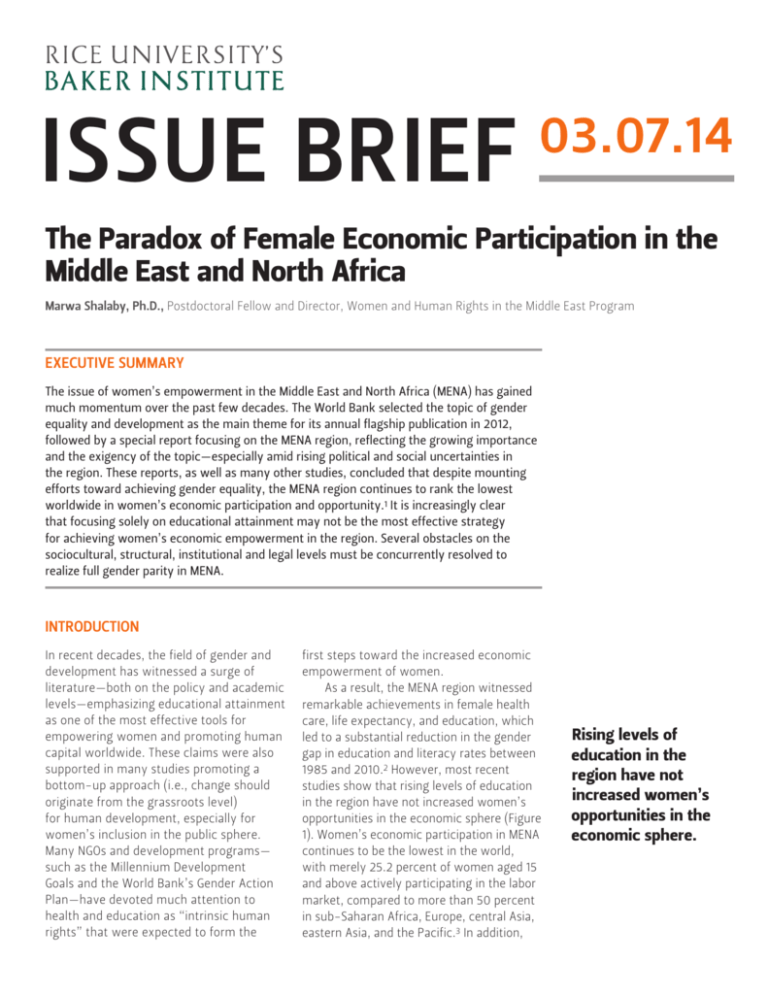
ISSUE BRIEF 03.07.14 The Paradox of Female Economic Participation in the Middle East and North Africa Marwa Shalaby, Ph.D., Postdoctoral Fellow and Director, Women and Human Rights in the Middle East Program EXECUTIVE SUMMARY The issue of women’s empowerment in the Middle East and North Africa (MENA) has gained much momentum over the past few decades. The World Bank selected the topic of gender equality and development as the main theme for its annual flagship publication in 2012, followed by a special report focusing on the MENA region, reflecting the growing importance and the exigency of the topic—especially amid rising political and social uncertainties in the region. These reports, as well as many other studies, concluded that despite mounting efforts toward achieving gender equality, the MENA region continues to rank the lowest worldwide in women’s economic participation and opportunity.1 It is increasingly clear that focusing solely on educational attainment may not be the most effective strategy for achieving women’s economic empowerment in the region. Several obstacles on the sociocultural, structural, institutional and legal levels must be concurrently resolved to realize full gender parity in MENA. INTRODUCTION In recent decades, the field of gender and development has witnessed a surge of literature—both on the policy and academic levels—emphasizing educational attainment as one of the most effective tools for empowering women and promoting human capital worldwide. These claims were also supported in many studies promoting a bottom-up approach (i.e., change should originate from the grassroots level) for human development, especially for women’s inclusion in the public sphere. Many NGOs and development programs— such as the Millennium Development Goals and the World Bank’s Gender Action Plan—have devoted much attention to health and education as “intrinsic human rights” that were expected to form the first steps toward the increased economic empowerment of women. As a result, the MENA region witnessed remarkable achievements in female health care, life expectancy, and education, which led to a substantial reduction in the gender gap in education and literacy rates between 1985 and 2010.2 However, most recent studies show that rising levels of education in the region have not increased women’s opportunities in the economic sphere (Figure 1). Women’s economic participation in MENA continues to be the lowest in the world, with merely 25.2 percent of women aged 15 and above actively participating in the labor market, compared to more than 50 percent in sub-Saharan Africa, Europe, central Asia, eastern Asia, and the Pacific.3 In addition, Rising levels of education in the region have not increased women’s opportunities in the economic sphere. RICE UNIVERSITY'S BAKER INSTITUTE // ISSUE BRIEF // 03.07.14 FIGURE 1 — FEMALE UNEMPLOYMENT RATES BY EDUCATION LEVEL the “gender wage gap” is also evident, with men making at least four times more than women in countries across the region. THE CONVENTIONAL WISDOM REVISITED SOURCE World Bank, 2013 FIGURE 2 — PERCENTAGE OF RESPONDENTS WHO BELIEVE MEN MAKE BETTER BUSINESS EXECUTIVES THAN WOMEN SOURCE World Values Survey 2008-2010 2 The World Development Report defines gender equality as “the accumulation of endowments (education, health, physical assets); the use of those endowments to take up economic opportunities and generate incomes; and the application of those endowments to take actions, or agency, affecting individual and household wellbeing.”4 Women across MENA have been provided with the necessary “endowments” (i.e., basic educational opportunities, better health, higher life expectancy) to achieve considerable success in the realm of education. However, they are still unable to fully exercise agency in the public sphere. There are several explanations why women in MENA lag behind in this area, and the main factors are sociocultural, structural, institutional, and legal. On the sociocultural level, women in the region still face many barriers due to the widespread belief that women are the upholders of tradition, and their duties should be confined to childbearing and taking care of their families. This has led to vertical (i.e., women having limited access to leadership positions in institutions) as well as horizontal (i.e., women being concentrated in specific professions in the labor market) gender occupational segregation.5 It is worth mentioning that most of these perceptions have very little to do with Islam or religious beliefs. The data in Figure 2 indicates the prevalence of negative perceptions about women in the labor force in Arab countries compared to other non-Arab Muslim and Western countries.6 Meanwhile, women who do enter the workforce are largely confined to socially acceptable professions, such as education, health care, agriculture, welfare, or volunteer work.7 This has led to a substantial gender gap in the fields of technology, engineering, and business administration. On the structural level, many non-oilproducing Arab countries adopted a number THE PARADOX OF FEMALE ECONOMIC PARTICIPATION IN THE MIDDLE EAST AND NORTH AFRICA of rigid economic policies that aggravated the distribution of resources and income with a direct impact on women’s employment.8 This impact was exacerbated by sluggish economic performance, soaring levels of inflation, and deteriorating trade levels and foreign direct investments.9 Female participation in the workforce is even lower in oil-producing Arab states, with female unemployment rates almost four times the male unemployment rates.10 This is mainly due to the effect of oil on the economies of these countries,11 as well as low incentives for women to be employed due to generous subsidies and family benefits. In addition to this economic participation gap, the gender wage gap in MENA is three times larger than in any of the emerging markets, estimated between 20 and 40 percent.12 On the institutional and legal levels, many countries in the region still lag behind in enforcing the necessary institutional and legal mechanisms to facilitate and promote women’s presence in the economic sphere. Several states in MENA lack adequate benefits for working parents, as well as strict labor laws against discrimination and violence against women in the workplace. In addition, rigid lending regulations and discriminatory treatment make it extremely difficult for women entrepreneurs in MENA to obtain credit.13 LOOKING AHEAD Increased access to economic opportunity is not only essential for improving women’s social status,14 but also for promoting a stronger presence in the decision-making process, especially on the political arena.15 To achieve this goal, all stakeholders should acknowledge that women’s economic empowerment in the region is a multifaceted and challenging issue that requires comprehensive and coordinated efforts on both local and international levels. In order to create an equitable workplace for women across MENA, change has to be initiated from within. Governments should make concerted efforts to close the widening gender gap in economic opportunities and wage distribution. Institutional mechanisms and strict enforcement of policies are needed to eliminate all forms of gender-based discrimination and provide women with more flexible work schedules, protection from harassment in the workplace, and equitable wages and benefits—in both the public and private sectors. Special training programs can better equip women with the necessary skills and tools for an increasingly competitive labor market. Furthermore, parallel efforts should focus on reshaping the prevailing cultural stereotypes and restrictive gender norms across MENA, with a focus on a more progressive, moderate form of female empowerment based on the values of Islam and tradition. Traditional and social media tools should play an active role in reinforcing and promoting these positive images. International actors should also focus on developing and facilitating programs geared toward women’s economic empowerment in the region, especially in places where women’s empowerment is politically motivated and enacted by the states. There are numerous initiatives led by international donors (such as Rouwwad, Women in Technology, Wamda for Women, etc.) that provide basic financial support and guidance to help women start their own businesses and become active in the workforce. Finally, international and domestic efforts should not solely focus on designing programs and promoting initiatives for women in poverty, but should also develop parallel efforts aimed at middle-class women—who have actually proved to outperform men in several educational specializations.16 Empowering this middle class would have a tremendous spillover effect, encouraging women to play more active roles in the political and social arenas. Over the course of the past few years, many of these middle-class women were at the forefront of the uprisings sweeping the region. Their demands were similar to their male counterparts: “Bread, Social Equality, and Dignity.” Equality of opportunity is at the heart of these demands—it is increasingly difficult to envision a prosperous, stable Middle East without these demands being met. Unconditional inclusion of women in the decision-making process is an urgent need that can’t be delayed any longer. The gender wage gap in MENA is three times larger than in any of the emerging markets, estimated between 20 and 40 percent. Increased access to economic opportunity is not only essential for improving women’s social status, but also for promoting a stronger presence in the decision-making process. 3 RICE UNIVERSITY'S BAKER INSTITUTE // ISSUE BRIEF // 03.07.14 ENDNOTES See more issue briefs at: www.bakerinstitute.org/issue-briefs This publication was written by a researcher (or researchers) who participated in a Baker Institute project. Wherever feasible, this research is reviewed by outside experts before it is released. However, the views expressed herein are those of the individual author(s), and do not necessarily represent the views of Rice University’s Baker Institute. © 2014 Rice University’s Baker Institute This material may be quoted or reproduced without prior permission, provided appropriate credit is given to the author and Rice University’s Baker Institute. Cite as: Shalaby, Marwa. 2014. The Paradox of Female Economic Participation in the Middle East and North Africa. Issue Brief no. 03.07.14. Rice University’s Baker Institute, Houston, Texas. 4 1. Ricardo Hausmann, Laura D. Tyson, and Saadia Zahidi, The Global Gender Gap Report 2012 (Geneva: World Economic Forum), http://www3.weforum.org/docs/ WEF_GenderGap_Report_2012.pdf. 2. World Bank, Capabilities, Opportunities and Participation: Gender Equality and Development in the Middle East and North Africa Region (Washington: World Bank, 2011), http://siteresources.worldbank.org/ INTMENA/Resources/World_Development_ Report_2012_Gender_Equality_ Development_Overview_MENA.pdf. 3. World Bank, Opening Doors: Gender Equality and Development in the Middle East and North Africa (Washington: World Bank, 2013), https://openknowledge.worldbank. org/bitstream/handle/10986/12552/751 810PUB0EPI002060130Opening0doors. pdf?sequence=1. 4. World Bank, World Development Indicators 2012 (Washington: World Bank, 2012), p. 4, http://data.worldbank.org/sites/ default/files/wdi-regional-highlights2012web.pdf. 5. Claudia Coris, “Working in a Hostile Environment: Female Labour Segregation and Women’s Impediments to Private Sector Opportunities in Jordan,” in Gender and Violence in Islamic Societies, edited by Zahia Smail Salhi (New York: I.B. Tauris, 2013). 6. World Values Survery 1981–2008 Official Aggregate v.20090901, 2009, World Values Survey Association (http://www. worldvaluessurvey.org), Aggregate File Producer: ASEP/JDS, Madrid. 7. OECD, Women in business: Policies to support women’s entrepreneurship development in the MENA region (OECD Publishing, 2012), http://www.keepeek. com/Digital-Asset-Management/oecd/ industry-and-services/women-inbusiness_9789264179073-en. 8. Shahida El-Baz, Globalization, Arab Women and Gender Equality (2013) http://www.forumdesalternatives. org/docs/caracas/es/Shahida_El_BazGlobalization,_Arab_Women_and_Gender_ Equality%7Bi%7D.pdf. 9. K. Elborgh-Woytek et al., “IMF Staff Discussion Note - Women, work, and the economy: Macroeconomic gains from gender equality,” 2013, https://www.imf.org/ external/pubs/ft/sdn/2013/sdn1310.pdf. 10. OECD, Women in business. 11. Michael L. Ross, “Oil, Islam and Women,” American Political Science Review 102 (2008): 107–123. 12. World Economic Forum, The Global Gender Gap Report (Geneva: World Economic Forum, 2012) http://www3.weforum.org/ docs/WEF_GenderGap_Report_2012.pdf. 13. Claire Mcloughlin, Helpdesk research report: Women’s economic role in the Middle East and North Africa, 2013, http://www. gsdrc.org/docs/open/HDQ889.pdf. 14. Elhum Haghighat, “Social Status and Change: The Question of Access to Resources and Women’s Empowerment in the Middle East and North Africa,” Journal of International Women’s Studies 14 (2013): 273–299. 15. Valentine Moghadam, and Lucie Senftova, “Measuring Women’s Empowerment: Participation and Rights in Civil, Political, Social, Economic, and Cultural Domains,” International Social Science Journal 57 (June 2005): 389–412, http:// onlinelibrary.wiley.com/doi/10.1111/j.14682451.2005.00557.x/abstract. 16. R. Aslan, “INSIGHT: Women in the workforce in the Arab world,” Middle East Voices, April 17, 2013, http:// middleeastvoices.voanews.com/2013/04/ insight-women-in-the-workforce-in-thearab-world-48868/. AUTHOR Marwa Shalaby, Ph.D., is the director of the Women and Human Rights in the Middle East Program at Rice University’s Baker Institute. She specializes in Middle Eastern politics, quantitative research methodology, and gender politics. Shalaby is currently working on a multi-country project exploring female political representation in the Middle East.
